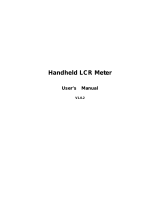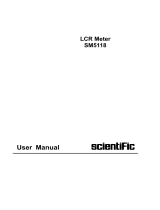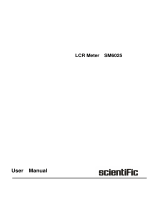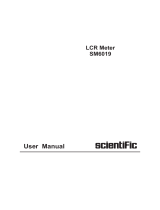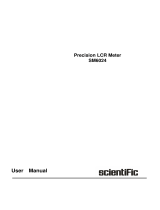Page is loading ...

Agilent
4284A/4285A
Precision LCR Meter Family
20 Hz to 1 MHz
75 kHz to 30 MHz
Technical Overview
A new standard
for precise component,
semiconductor and
material measurements
Advanced Test Equipment Rentals
www.atecorp.com 800-404-ATEC (2832)
®
E
s
t
a
b
l
i
s
h
e
d
1
9
8
1

2
Agilent
precision LCR meter family
Utilize state-of-the art
measurement technologies
• 6-digits of resolution at any range
• Basic accuracies of
0.05% (Agilent 4284A) and
0.1% (Agilent 4285A)
• 20 impedance parameters to access
and measure
• Constant V or I test signal level
• 20 Vrms test signal level
(Agilent 4284A)
Move your process toward
error-free operation
• Instrument setup state storage
• Comparator functions
• Selectable frequency error
corrections
• Open, short and load corrections
remove parasitics
Key specifications
Agilent 4284A precision LCR meter
Test frequency 20 Hz to 1 MHz over 8610 selectable frequencies
Measurement range1
|Z|, R, X :0.01 mΩto 99.9999 MΩ
|Y|, G,B :0.01 nS to 99.9999 S
C :0.01 fF to 9.99999 F
L :0.01 nH to 99.9999 kH
D :0.000001 to 9.99999
Q :0.01 to 99999.9
Basic accuracy |Z| , C and L:0.05% D:0.0005
Test signal level range
Voltage 5 mVrms to 2 Vrms
Current 50 µArms to 20 mArms
Constant test signal level range
Voltage 10 mVrms to 1 Vrms
Current 100 µArms to 10 mArms
Measurement time 239 ms/190 ms/830 ms at 1 kHz
4284A with Option 4284A-001
Test signal level range
Voltage 5 mVrms to 20 Vrms
Current 50 µArms to 200 mArms
Constant test signal level range
Voltage 10 mVrms to 10 Vrms
Current 100 µArms to 100 mArms
Internal DC bias ± (1 mV ~ 40 V), ≤100 mA, 0.1% accuracy
4284A with Option 4284A-002 and 42841A
DC current bias 0.01 A to 20 A (with 42841A and 42842A)
0.02 A to 40 A (with 42841A x 2 ea., 42842B and 42843A)
1. Refer to specifications for complete accuracy.
2. Supplimental information only.

3
Satisfying your
performance needs
Adapt instrument configurations
to fit your test needs
• Internal voltage biasing up to ±40 Vdc3
• High current biasing up to 40 A dc3
(Agilent 4284A)
• Wide range of frequencies, 20 Hz to
30 MHz
• BIN’ing and comparator functions for
handlers
• SMD, axial and radial test fixtures3
Simplify your system
development and integration
• Programming language compatible
with IEEE 488.2
• Test port extensions: maximum 4 m
for 4284A3and 2 m for 4285A
• Identical operation for the entire
family of products
• Scanner, handler and GPIB interfaces3
Key specifications
Agilent 4285A precision LCR meter
Test frequency 75 kHz to 30 MHz with 100 Hz resolution
Measurement range1
|Z|, R, X :0.01 m Ωto 99.9999 MΩ
|Y|, G,B :0.01 nS to 99.9999 S
C :0.01 fF to 999.999 µF
L :0.001 nH to 99.9999 H
D :0.000001 to 9.99999
Q :0.01 to 99999.9
Basic accuracy |Z|, C and L:0.1% D:0.001
Test signal level range
Voltage 5 mVrms to 2 Vrms
Current 200 µArms to 20 mArms
Constant test signal level range
Voltage 10 mVrms to 1 Vrms
Current 100 µArms to 20 mArms
Measurement time230 ms/65 ms/200 ms
4285A with Option 4285A-001
Internal DC bias ± (1 mV ~ 40 V), ≤100 mA, 0.1% accuracy
4285A with Option 4285A-002, 42841A, and 42842C
DC current bias 0.01 A to 10 A
1. Refer to specifications for complete accuracy.
2. Supplimental information only.
3. The options, the accessories, or the test fixtures
are needed.

Dissipation factor rise
due to high ac signal
4
Versatile component
measurements
Characterize inductive devices
• Sweep high current conditions
• Identify device properties precisely
• Test to RF frequencies
Low frequency measurements:
Agilent 4284A
Inductive devices can now be accurately
characterized from 20 Hz to 1 MHz with a
dc bias current up to 40 A1dc.
High frequency measurements:
Agilent 4285A
The Agilent 4285A’s wide 75 kHz to 30 MHz
range allow you to test RF inductors with
improved accuracy and 0.001 nH resolution.
Magnetic heads, ferrite-cores, and power
inductors that need to be tested at a
specified current signal level can be easily
tested with the Agilent 4285A.
Precise ceramic
capacitor measurements
• Test at 1 kHz and 1 MHz
• Resolve measurements to low values
• Maintain constant signal levels
1 kHz and 1 MHz are the primary testing
frequencies for ceramic materials and
capacitors. The Agilent 4284A can provide
these test frequencies while maintaining
an equally excellent accuracy and 6-digits
of measurement resolution.
1 MHz accuracies of capacitance (0.05%)
and dissipation factor (0.0005) are essential
for characterizing DUTs with low dissipation
factors. Dissipation factors can change as
a function of the applied test signal level
to the DUT. For reliable and consistent
measurements, the Agilent 4284A can
maintain a constant voltage test signal
level.
Inductance rolloff due
to high dc current bias
1. Need Option 4284A-001

C-V characteristics
sample—MOS diode
5
Adaptable
parameter testing
Discover new material properties
• High accuracy and precise
measurements
• Wide frequency ranges
• High test signal levels
• Agilent 16451B dielectric test fixture
The Agilent precision LCR meter family
provides the accuracy, resolution, high
test signal and bias levels1required for
material measurements. Using the
Agilent 16451B dielectric test fixture
provides you with accurate permittivity
and dissipation factor measurements.
The ability to output a constant test signal
level permits repeatable and accurate
magnetic/dielectric measurements. Both
the Agilent 4284A and Agilent 4285A offer
variable voltage and current test signal
level control.
Semiconductor testing
• Extend the test cable to the DUT
• Detect small parameter changes
• Rapidly acquire data
• Test at multiple frequencies
Both instruments allow you to extend the
front panel measurement port through test
cables, switches, and probers directly to
the DUT. The 6-digits of resolution give
you the ability to sense and identify
changes not normally seen by conventional
LCR meters.
The accuracies of the Agilent 4284A at
key test frequencies up to 1 MHz permit
complete DUT evaluation for either
production or laboratory needs.
For high speed device testing at frequen-
cies above 1 MHz, the best solution is the
Agilent 4285A.
A material’s
characteristics versus
frequency
1. Need Option 4284A/4285A-001

6
Production test
Reduce production test factors
• Increase test throughput
The precision LCR meter family reduces testing costs
by providing accurate high throughput testing.
• Interface easily to handlers
Built-in comparator, cable compensation1, and interfaces2
permit system integration.
• Minimize operator error
Instrument state storage minimizes costly setup errors.
Quality assurance
Automated quality assurance
• Reduce your system development time
The Agilent 4284A and Agilent 4285A are designed to be used
as elements in systems. This means GPIB, programming,
and the ability to interface with scanners3.
• Painlessly integrate the system
GPIB and a scanner3interface allow the instruments to easily
integrate into system configurations.
• Leverage your programming experience
Learning to program one instrument automatically means
you learn both.
One LCR meter family
for your product’s life cycle
Research and development
Research tomorrow’s electronic components now
• Increase measurement confidence
The basic accuracies are:
Agilent 4284A 0.05% and Agilent 4285A 0.1%.
• Detect 1 ppm changes
The 6-digits of resolution permit you to measure differences
in materials not detectable before.
• Fit the instrument to your test needs
For low frequency applications the Agilent 4284A is the ideal
tool. For testing at RF frequencies the Agilent 4285A is the
best solution.
Material design
Design and test new materials
•Material test fixtures
For accurate permittivity and dissipation factor measurements
of solid dielectric materials, the 16451B dielectric test fixture
is provided. The 16452A liquid test fixture is provided for the
permittivity measurements of liquids with minimal conductivity.
• Sample program
By using the sample program in the operation manual of
16451B, complex permittivity can be calculated rather easily
and instantly. In addition, with the use of a spreadsheet soft
ware, the frequency response of permittivity can be displayed
in a graph.
1. For 4284A, need Option 4284A-006
2. Choose the combination from Option 4284A/4285A-201, 4284A/4285A-202, or
4284A/4285A-301
3. Need Option 4284A/4285A-301

7
Comprehensive incoming inspection
Satisfying difficulties and requirements
of impedance measurements during
incoming inspection
Many types of measurements requiring a variety of measurement
conditions have to be carried out during incoming inspection.
However, as measurement instruments cannot perform all of the
measurements required, substitute measurements are made. On
the other hand, purchasing all the necessary equipment would
substantially increase capital costs.
By employing the precision LCR meter family, a wide frequency
range is covered (20 Hz to 1 MHz for 4284A and 75 kHz to
30 MHz for 4285A) and various test signal levels can be set
(20 Vrms/200 mArms for 4284A Option 4284A-001 and
2 Vrms/20 mArms for 4285A). In addition, the ALC function
allows measurements of constant-voltage and constant-current
signals, and the added capability of Option 4284A/4285A-001
enables up to ±40 V of dc bias to be applied to the DUT. As a
result of these features, a variety of measurement conditions can
be carried out.
Furthermore, the precision LCR meter family achieves high accuracy
measurements (basic |Z| measurement accuracy: 0.05% for
4284A and 0.1% for 4285A), permitting the characteristics of
inductors and capacitors to be evaluated with excellent reliability.
Also, built-in compensation functions reduce the influence of test
fixtures to a minimum, further raising the reliability.
Built-in functionalities
for efficient measurements
In order to save time and facilitate the efficiency of measurement
routines, the precision LCR meter family has the following features.
The memory card1 allows the measurement conditions to be pre-
set for various components with different measurement needs.
The comparator function can be set to sort into a maximum of 10
BINs, enabling many components to be handled during inspection.
The Option 4284A/4285A-301 scanner interface solves the prob-
lem of having discrepancies in measurement values for different
channels of the switching matrix by allowing channel compensa-
tion for up to 128 channels.
1. Need Option 4284A/4285A-004

8
User friendly Interface
Simple front panel operation
• Clearly view the display
• See all instrument settings
• Interactive softkeys for simple control
Directly view all instrument settings and
measurement results on the large LCD
display. This simplifies operation and
improves operator efficiency by minimizing
readout error.
The softkeys simplify front panel operation
by allowing the user to easily change
instrument states by moving the LCD
cursor with cursor keys. The softkeys
will automatically change to reflect the
cursor’s position. This minimizes the
number of menus and key strokes.
Non-volatile memory
• Eliminate costly setup errors
• Increase user productivity
• Archive tests
The instruments contain two types of user
accessible memory; internal and external
(memory cards)1. The memory can easily
be used to store measurement setups.
Later, a setup can be loaded back into the
instrument. This reduces test setup errors
and increases the user’s productivity.
The memory can store 10 different instru-
ment states, complete with correction
data and system configuration. Entire
setups including limit information can
now be stored and loaded using either
the internal memory or the memory card1.
The memory card1system is completely
electronic and is based on EEPROM.
Customized test frequencies
Inserting the memory card1
1. Need Option 4284A/4285A-004

9
Testing with the
proper tools
Measure the components’
performance in your
power supply
• Test your components under load
conditions
• Bias inductive devices with high
currents
• Satisfy your needs with the right
instrument
Designing advanced switching power
supplies require the use of inductors and
transformers that operate in the RF
regions.
For low frequencies, the Agilent 4284A1
precision LCR meter with the
Agilent 42841A bias current source,
and the 42842A/B bias current test
fixtures all combine to form a 40 A dc
test system.
Where a high frequency measurement
is required, use an Agilent 4285A2, an
Agilent 42842C bias current test fixture,
and an Agilent 42841A bias current source
to achieve up to 10 A dc biasing with
measurements at 30 MHz.
Reduce system
development time
The 4284A and 4285A employ a program-
ming language, which is compatible with
the IEEE 488.2. Since the command names
are similar to the measurement functions,
the time spent for creating and debugging
programs can be largely minimized. The
operation manual lists several key sample
programs, allowing the user to efficiently
create a program for their measurement
system.
High current bias for inductor testing under load conditions
Code generation made easy
1. Need Option 4284A-002
2. Need Option 4285A-002

10
Specifications
All specifications are common
to the Agilent 4284A and Agilent 4285A
unless otherwise noted.
Measurement functions
Measurement parameters
|Z| (impedance), |Y| (admittance), q(phase), R (resistance), X (reactance),
G (conductance), B (susceptance), L (inductance), C (capacitance), Q (quality factor),
D (dissipation factor), ESR (equivalent series resistance) and Rp (parallel resistance).
20 parameter combinations are available
Equivalent circuit modes: Series and parallel
Mathematical functions: Deviation and percent deviation
Trigger: Internal, external and manual
Delay time: 0 to 60.000 s in 1 ms steps
Measurement terminals: Four-Terminal Pair
Test cable lengths:
Agilent 4284A-standard: 0 and 1 meter
Option 4284A-006: adds 2 and 4 meter extension
Agilent 4285A-standard: 0.1 and 2 meters
Integration time: Short, medium and long
Test signal
Test frequency:
Agilent 4284A: 20 Hz to 1 MHz, 8610 selectable frequencies
Agilent 4285A: 75 kHz to 30 MHz, 100 Hz steps
Frequency accuracy: ±0.01%
Output impedance:
Agilent 4284A: standard: 100 Ω±3%
Option 4284A-001: 100 Ω±6%
Agilent 4285A: (25 + 0.5 fm) Ω±10% @ 1 MHz, ±30% @ 30 MHz,
fm= test frequency in MHz
AC test signal modes:
Normal: Programs selected voltage or current at the measurement
terminals when they are opened or shorted, respectively.
Constant: Maintains selected voltage or current at the device
under test independent of changes in the device’s
impedance.
AC test signal
Agilent 4284A: standard
Range Accuracy
Normal V 5 m Vrms to 2 Vrms ±(10% + 1 mVrms)
I 50 µArms to 20 mArms ±(10% + 10 µArms)
Constant V 10 m Vrms to 1 Vrms ±(6% + 1 mVrms)
I 100 µArms to 10 mArms ±(6% + 10 µArms)
Agilent 4284A with Option 4284A-001
Range Accuracy
Normal V 5 m Vrms to 20 Vrms ±(10% + 1 mVrms)
I 50 µArms to 200 mArms ±(10% + 10 µArms)
Constant V 10 m Vrms to 10 Vrms ±(10% + 1 mVrms)
I 100 µArms to 100 mArms ±(10% + 10 µArms)
Specifications continued on page 11

11
Agilent 4285A: standard
Range Accuracy
Normal V 5 m Vrms to 2 Vrms ±(8% + 0.4 fm% + 1 mVrms)
I 200 µArms to 20 mArms ±(8% + 1 fm% 40 µArms)
Constant V 10 m Vrms to 1 Vrms ±(6% + 0.2 fm%+ 1 mVrms)
I 100 µArms to 20 mArms ±(6% + 0.2 fm%+ 40 µArms)
fm: test frequency in MHz
DC bias:
Standard: 0 V, 1.5 V and 2 V (Agilent 4284A only)
With
Option 4284A/4285A-001: 0 V to ±40 V Rear panel DC bias monitor, BNC connector
Range Resolution Accuracy
±(0.000 to 4.000) V 1 mV ±(0.1% to 1 mV)1
±(4.002 to 8.000) V 2 mV ±(0.1% to 2 mV)1
±(8.005 to 20.000) V 5 mV ±(0.1% to 5 mV)1
±(20.01 to 40.00) V 10 mV ±(0.1% to 10 mV)1
Measurement range
Parameter Range
|Z|, R, X: 0.01 mΩto 99.9999 MΩ
|Y|, G, B: 0.01 nS to 99.9999 S
C: 4284A: 0.01 fF to 9.99999 F
4285A: 0.01 fF to 999.999 µF
L: 4284A: 0.01 nH to 99.9999 kH
4285A: 0.001 nH to 99.9999 H
D: 0.000001 to 9.99999
Q: 0.01 to 99999.9
q: -180.000° to 180.000°
∆% -999.999% to 999.999%
Display
LCD Dot-matrix type display. Capable of displaying: measured values, control
settings, comparator limits and decisions, list sweep tables, self test messages
and annunciations.
Correction function
Open/short: Eliminates measurement errors due to stray parasitic
impedance in the test fixture.
Load: Improves measurement accuracy by using a calibrated
device as a reference.
List sweep function
A maximum of ten frequencies or test levels can be programmed. Single or
sequential testing can be performed. When Option 4284A/4285A-001 is installed,
dc bias sweep can also be performed.
Specifications continued on page 12
Specifications
Continued from page 10
1. Refer to measurement accuracy.

12
Comparator function
Ten bin sorting for the primary measurement parameter, IN/OUT for the secondary
measurement parameter.
Bin count: 0 to 999999
List sweep comparator: HIGH/IN/LOW decision output for each point in the list
sweep table.
Other functions
Store/load: Ten instrument setups can be stored/loaded from the
internal non-volatile memory. Ten additional setups can
also be stored/loaded from each memory card1.
GPIB: All instrument control settings, measured values,
comparator limits, list sweep tables, and self test results.
Memory: Memory buffer can store a maximum of 128 measurement
results and output the date over GPIB, ASCII and 64 bit
binary data formats.
Options
Option 4284A/4285A-001: Power amplifier/dc bias
This option cannot be operated simultaneously with
Option 4284A/4285A-002.
Agilent 4284A: Increases the AC test signal to 20 Vrms/0.2 Arms.
Extends bias range to variable ±40 Vdc. Rear panel BNC
for dc voltage monitor.
Agilent 4285A: Adds variable ±40 Vdc. Rear panel BNC for dc voltage
monitor and current monitor.
Option 4284A/4285A-002: Accessory control interface/bias current
Interface allows the Agilent precision LCR meter to
control the Agilent 42841A bias current source.
This option cannot be operated simultaneously with
Option 4284A/4285A-001.
Option 4284A-006: 2 m/4 m cable length operation (4284A only)
Increases test cable length capability. Adds 2 and 4
meter operation.
Option 4284A/4285A-201: Handler interface
This is a general purpose comparator/handler interface.
Nine-sets of HIGH/LOW limits can be input allowing
10-bin sorting for L, C, or IZI. The handler interface
enables systemization with an automatic component
sorting machine. All signals are optically isolated.
Option 4284A/4285A-202: Handler interface
Option 4284A/4285A-301: Scanner interface
Open/short/load correction data for multiple channels
is stored in non-volatile memory, a maximum of 128 for
the Agilent 4284A and 90 for the Agilent 4285A. Three
frequencies can be corrected on the Agilent 4284A
while seven frequencies can be corrected on the
Agilent 4285A.
Specifications continued on page 13
Specifications
Continued from page 11
1. Need Option 4284A/4285A-004

13
General
Power requirements 100 V/120 V/220 V ±10%, 240 V +5%/-10%,
47 Hz to 66 Hz.
Power consumption 200 VA
Operating temperature
and humidity 0 °C to 55 °C, < 95% RH at 40 °C
Size 426(W) x 177(H) x 498(D) mm
Weight Agilent 4284A: 15kg (33lb.) Agilent 4285A: 16kg (35.2lb.)
Supplemental performance characteristics (Not guaranteed)
Agilent 4284A
Stability Medium integration and constant operating temperature
of 23 °C ±5 °C.
|Z|, |Y|, L, C, R < 0.01%/day D < 0.0001/day
Temperature coefficient Medium integration and 23 °C ±5 °C.
Agilent 4285A
Stability Long integration and constant operating temperature
of 23 °C ±5 °C.
≤1 MHz 30 MHz
|X|, |Y|, L, C, R 0.01 %/day < 0.05 %/day
D 0.0001/day < 0.0005/day
Temperature coefficient Long integration, test signal voltage ≥20 mVrms
and 23 °C ±5 °C.
≤1 MHz 30 MHz
|X|, |Y|, L, C, R 0.004%/°C <0.05%/°C
D 0.00004/°C <0.0005/°C
Settling time
Frequency
4284A < 70 ms; fm≥1 kHz
< 120 ms; 100 Hz ≤fm< 1 kHz
< 160 ms; fm< 100 Hz
4285A < 50 ms
Test signal < 120 ms (4284A) < 100 ms (4285A)
Range < 50 ms/range shift; fm≥1 kHz
Input protection Internal circuit protection, when a charged capacitor is
connected to the unknown terminals. The maximum
capacitor voltage is:
Vmax =√1/C (v) where: Vmax ≤200 V
C is in Farads
Specifications continued on page 14
Specifications
Continued from page 12

14
Measurement time Time interval from a trigger command to the EOM
(end of measurement) signal output at the handler
interface port.
Agilent 4284A setting time
Integrated time 100 Hz 1 kHz 10 kHz 1 MHz
Short 270 ms 40 ms 30 ms 30 ms
Medium 400 ms 190 ms 180 ms 180 ms
Long 1040 ms 830 ms 820 ms 820 ms
Agilent 4285A setting time
Integrated time 75 kHz ~ 30 MHz
Short 30 ms
Medium 65 ms
Long 200 ms
Option 4284A/4285A-001: DC bias current output: 100 mA max
Measurement accuracy (Agilent 4284A only)
The following conditions must be met:
1. Warm up time: ≥30 minutes
2. Ambient temperature: 23 °C ±5 °C
3. Test signal voltage: 0.3 Vrms to 1 Vrms
4. Test cable length: 0 m
5. Open and short corrections have been performed
6. D ≤0.1 for C, L, X and B measurements
Q ≤0.1 for R and G measurements
See operation manual for additional conditions.
Accuracies are relative to calibrated standards. Absolute accuracies are given as:
(Agilent 4284A’s relative accuracy +calibration uncertainty of standards).
Accuracy equations
|Z|, |Y|, L, C, R, X, G and B accuracies are given as:
±[A + (Ka+ Kb+ Kc) x 100] (% of reading)
where: 1. A is basic accuracy as shown in figure 1
2. Kaand Kbare impedance proportional factors given in Table 2.
The Katerm is negligible for impedance above 500 Ω.
The Kbterm is negligible for impedances below 500 Ω.
3. Kcis the calibration interpolation factor given in Table 1.
D accuracy is given as:
±[Ae/100] (absolute D value)
where: 1. Ae= [A + (Ka+ Kb+ Kc) x 100]
Q accuracy is given as (when Qx x De< 1):
±[(Qx2x De)/(1 ](Qx x De)] (absolute Q value)
where: 1. Qxis the measured Q value
2. Deis the D accuracy
Specifications continued on page 15
Specifications
Continued from page 13

15
qaccuracy is given as:
±[(180/p) x (Ae/100)] (absolute degrees)
where: 1. Ae= [A + (Ka+Kb+Kc) X 100]
Additional error due to temperature:
Multiply the measurement accuracy by the following temperature factors.
Example C and D accuracy calculation
Measurement conditions:
Frequency: 1 kHz
Capacitance value: 100 nF
Test signal level: 1 Vrms
Integration time: Medium
Calculation:
Step 1: Use Figure 1 to determine A and Zm.
a. Find the frequency along the X-axis.
b. Find the capacitance value along a diagonal.
c. Note the intersection of the values from steps a and b.
Interpolation may be necessary.
d. Each shaded area has two values for A; the upper
number is for medium and long integrations, the
lower number is for short integration. A = 0.05%.
Find Zmby extrapolating horizontally to the Y-axis
(impedance axis). Zm= 1590 Ω
Step 2: Use Tables 1 and 2 to find Ka, Kband Kc.
a. Use the equations in Table 2 to find Kaand Kb.
Ka= (1 x 10-3 /1590)(1+(200/1000)) = 7.5 x 10-7
Kb= (1590(1 x 10-9) (1 + 70/1000)) = 1.67 x 10-6
b. Use Table 1 to find Kcfor the given frequency.
Kc= 0
Step 3: Calculate C and D accuracy.
C = 0.05 + (7.5 x 10-7 + 1.67 x 10-6 + 0) x 100% = 0.05%
D = 0.05/100 = 0.0005
Table 1. Kc: Calibration interpolation factor
Frequency Kc
Direct correction frequencies 0
All other frequencies 0.0003
Note: Direct calibration frequencies are 20, 25, 30, 40, 50, 60, 80, 100, 120, 150, 200Hz.
Sequence repeats for each decade up to 1 MHz. 48 frequencies total.
Specifications continued on page 16
Specifications
Continued from page 14

16
Table 2. Kaand Kb: Impedance proportional factors
Notes: 1. fmis the test frequency in (Hz)
2. |Zm| is the device’s impedance
3. Vs is the test signal level in (mVrms)
Specifications continued on page 17
Specifications
Continued from page 15

17
Figure 1. Baseline accuracy facto (4284A)
(For additional accuracy information refer to the impedance accuracy equation on page 14.)
Notes: 1. Test signal level: 0.3 Vrms to 1 Vrms
2. Upper number, medium and long integration
3. Lower number, short integration
Specifications continued on page 18
Specifications
Continued from page 16

18
Additional specifications (Agilent 4284A only)
When measured value < 10 mΩ, |Z|, R, and X accuracy, which is described on page 14,
is given as following equation.
|Z|, R, and X accuracy:
•±[(Ka + Kc) x 100] (%)
Where
• Ka = Impedance proportional factor (refer to Table 2)
• Kc = Calibration interpolation factor (refer to Table 1)
Measurement accuracy (Agilent 4285A only)
Accuracy is specified for the following conditions:
1. Warm up time: ≥30 minutes
2. Ambient temperature: 23 °C ±5 °C
3. Test signal level voltage: 0.2 Vrms to 1 Vrms
4. Test cable correction completed
5. Open and short corrections have been completed
6. D ≤0.1 for C, L, X and B measurements
Q ≤0.1 for R and G measurements
7. For test frequencies above 10 MHz and DUT impedance ≥5 kΩ, the test signal
level must be between 0.5 Vrms and 1 Vrms
These accuracies are absolute and include the calibration uncertainties of standards.
Refer to the operation manual for additional setup conditions.
Accuracy equations
|Z|, |Y|, L, C, R, X, G and B accuracies are given as:
±(An + B) (% of reading)
where: 1. Anis the accuracy equation as specified by Figure 2 and
Table 3. Anranges from A1to A8.
2. B is the test cable length factor in Table 5.
D accuracy is given as:
±[Ae/100] (absolute D value)
Note: Ae= (An + B)
Q accuracy is given as:
±[(Qx2x De)/(1 ](Qx x De)] (absolute Q value)
Note: Specification valid only when QxDe < 1. Qxis the measured
value of Q. Deis the computed D accuracy.
Specifications
Continued from page 17
Specifications continued on page 19

19
Table 3. Accuracy equations
Specifications continued on page 20
Specifications
Continued from page 19

20
qaccuracy is given as:
±[(180/p) x (Ae/100)] (absolute degrees)
Note: 1. Ae= (An+ B)
Additional error due to temperature:
Multiply the measurement accuracy by the following temperature factors.
Example L and Q accuracy calculation
Measurement conditions:
Frequency: 500 kHz L value measured: 2 mH
Test signal level: 1 Vrms Integration time: Long
Cable length: 0 meters Q value measured (Qx): 200
Calculation:
Step 1: Use Figure 2 to determine Anand Zm.
a. Find the frequency along the X-axis.
b. Find the inductance value along a diagonal.
c. Note the intersection of steps a and b.
In this case An= A5. Refer to the equations in Table 3.
d. Note that in step c Zmis 6.3 kΩ.
Step 2: Use Tables 3 and 4 to determine Anand B.
a. Anis equation A5for long integration times:
0.18% + [(|Zm|/5 k) x 0.02%]
b. A5yields a value of 0.21%
c. Table 4 indicates that B has a value of 0.
(@ cable length = 0 m)
d. L accuracy is ±(An+ B) = 0.21%
e. Determine D accuracy (De): (An+ B)/100 = 0.0021
f. Q accuracy: (∆Q)
±[(Qx2x De)/(1 ] (Qxx De)]
g. ∆Q yields a value of –57 to 133, Actual Q: 143 to 333
N1, N2and N3are in Table 3.
Table 4. Cable length correction
Test cable length B (%)
0 meter 0
1 meter (16048A) fm/15
2 meter (16048D) fm/15
(fm: test frequency in MHz)
Specifications continued on page 21
Specifications
Continued from page 19
/
